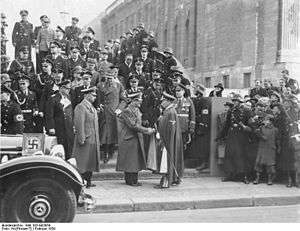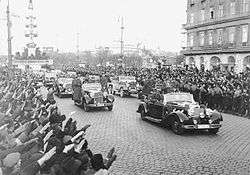SS-Begleitkommando des Führers
| SS-Begleitkommando des Führers; Führerbegleitkommando | |
|---|---|
 Führerbegleitkommando and other uniformed SS men providing security for Hitler in February 1939 | |
| Active | 29 February 1932 – 30 April 1945 |
| Country |
|
| Allegiance | Axis |
| Branch |
|
| Role | Bodyguards |
SS-Begleitkommando des Führers ("SS Escort Command of the Führer"), later known as the Führerbegleitkommando (Führer Escort Command; FBK) was originally an eight-man SS squad formed from a twelve-man security squad (known as the SS-Begleitkommando) tasked with protecting the life of Adolf Hitler during the early 1930s. It was expanded and remained responsible for Hitler's personal protection until 30 April 1945.
Service history
The SS-Begleitkommando was formed on 29 February 1932 to provide general protection to Hitler and other party functionaries. Twelve SS members were selected by Sepp Dietrich to present to Hitler.[1] From the twelve, a smaller eight-man team called the SS-Begleitkommando des Führers was chosen to protect Hitler as he travelled around Germany.[1] Their first appearance was when they accompanied Hitler during the election campaign trips in 1932. They served around the clock protecting Hitler.[2]
In the spring of 1934, the Führerschutzkommando (FSK) replaced the SS-Begleitkommando des Führers for Hitler's overall protection throughout Germany.[3] The small SS-Begleitkommando des Führers unit continued to provide personal security for Hitler.[4] The FSK was also responsible for general security measures, preventive measures, and prosecution of assassination attempts.[5] The Führerschutzkommando was officially renamed the Reichssicherheitsdienst (Reich Security Service; RSD) on 1 August 1935.[6] The RSD and the SS-Begleitkommando cooperated with the Ordnungspolizei (uniformed order police), Gestapo, and other agencies to provide the inner security requirements, whereas outer protection was handled by general SS units.[7]
Expansion and renamed
Later the SS-Begleitkommando was expanded and became known as the Führerbegleitkommando (Führer Escort Command; FBK).[8] By 1937, the unit had grown to 37 members.[9] The FBK continued under separate command and to provide close, personal security for Hitler.[10] The additional members for the FBK were drawn from 1st SS Panzer Division Leibstandarte SS Adolf Hitler (LSSAH).[11] Hitler used them for guard duty, but also as orderlies, valets, waiters, and couriers.[11] Although the FBK was administratively under the control of the LSSAH, they received their orders directly from Hitler and in latter years from his chief adjutant, Julius Schaub through the day-to-day operational orders given to Johann Rattenhuber, chief of the RSD.[6]

When on duty, the FBK members were the only armed personnel Hitler allowed to be near him.[12] They never had to surrender their Walther PPK 7.65 pistols and were never searched when they were with Hitler.[13] For motorcades, following Hitler's Mercedes-Benz would be two cars to the left and right, one with FBK men and the other with a detachment of RSD men.[14] The FBK and RSD worked together for security and protection during trips and public events, but they operated as two groups and used separate vehicles. RSD chief Johann Rattenhuber was in overall command and the current FBK chief acted as his deputy.[15] By March 1938, both units wore the standard field grey uniform of the Schutzstaffel (SS). Both units were under the control of the SS and both units were made up of SS members.[16] The RSD uniform had the Sicherheitsdienst (SD) diamond on the lower left sleeve.[17] The term Begleit-Kommando or Begleitkommando-SS were used at times when referring to the Führerbegleitkommando.[18]
The FBK accompanied Hitler on all his travels and was always present at the different Führerhauptquartiere (Führer Headquarters; FHQ) located in various parts of occupied Europe during World War II.[19][20] Wherever Hitler was in residence, members of the FBK and RSD would be present. The RSD men patrolled the grounds and the FBK men provided close security protection. For special events, the number of LSSAH guards, which provided an outer ring of protection were increased.[21][22] By June 1941, the FBK had grown to 35 members. Later by 15 January 1943 it had expanded to 31 SS officers and 112 men.[9] Thirty-three were used in escort duties, rotating in groups of eleven. The rest were used as guards for Hitler's residences "not in use at the time" and as drivers, orderlies, valets, waiters, couriers and for communication duties.[9][23]
Wolf's Lair FHQ
Hitler's most famous military FHQ during the war was the Wolf's Lair (Wolfsschanze). He spent more time at that Eastern Front military field headquarters than any other. Hitler first arrived at the headquarters in June 1941. In total, he spent more than 800 days there during a 3 1⁄2-year period until his final departure on 20 November 1944.[24] It was guarded by personnel from the RSD, and Führerbegleitbrigade (FBB). The FBK men were also present when Hitler was there.[25] It had several security zones. Sperrkreis 1 (Security Zone 1) was located at the heart of the Wolf's Lair. Ringed by steel fencing and guarded by RSD and FBK men, it contained Hitler's bunker and ten other camouflaged bunkers built from 2 metres (6 ft 7 in) thick steel-reinforced concrete.[26][27] Sperrkreis 2 (Security Zone 2) surrounded the inner zone. This area housed the quarters of several Reich ministers, the HQ personnel, two messes, a communication centre, as well as the military barracks for the FBB. Sperrkreis 3 (Security Zone 3) was a heavily fortified outer security area which surrounded the two inner zones. It was defended by land mines and FBB personnel, which manned guard houses, watchtowers and checkpoints. Despite the security, the most notable assassination attempt against Hitler was made at the Wolf's Lair on 20 July 1944.[28][29]
1945
SS-Obersturmbannführer Franz Schädle was appointed the last FBK commander on 5 January 1945, after the dismissal of Bruno Gesche.[30] On 16 January 1945, following the Wehrmacht's defeat in the Battle of the Bulge, Schädle, the FBK and the rest of Hitler's personal staff moved into the Führerbunker and Vorbunker.[31] The bunker complex was under the Reich Chancellery garden in the central government sector of Berlin.[30] By 23 April 1945, Schädle commanded approximately 30 members of the unit who stood guard for Hitler until his suicide on 30 April 1945.[32] During that last week of April the remaining FBK and RSD men had been withdrawn from the "exposed sentry posts" on the Chancellery roof and outside of the Führerbunker entrances due to the heavy Soviet artillery shelling of the area.[33]
After Hitler's death, orders were issued that all who could do so were to break out from the Soviet Red Army ring. The plan was to escape from Berlin to surrender to the Western Allies on the Elbe or join the German Army to the North. Schädle did not join one of the break out groups. According to the bunker's master electro-mechanic Johannes Hentschel, by that time Schädle's shrapnel leg wound had become gangrenous. He could only walk at a slow pace using a crutch.[34][35] Schädle committed suicide by shooting himself in the mouth with a pistol, rather than attempt the break out from the surrounded Reich Chancellery.[30]
Original members
- Bodo Gelzenleuchter[1]
- Willy Herzberger[36]
- Kurt Gildisch[36]
- Bruno Gesche[30]
- Franz Schädle[30]
- Erich Kempka[1]
- August Körber[1]
- Adolf Dirr[1]
Commanders
RSD Commander:
- Johann Rattenhuber (1933–1945)[37]
SS-Begleitkommando (later known as: FBK) Commanders:
- Bodo Gelzenleuchter: March 1932 to later that same year[36]
- Willy Herzberger: Later part of 1932 to 11 April 1933[36]
- Kurt Gildisch: 11 April 1933 to 15 June 1934[36]
- Bruno Gesche: 15 June 1934 to April 1942 and December 1942 to December 1944[38]
- Franz Schädle: January to April 1945[30]
Notable FBK members
See also
References
Citations
- 1 2 3 4 5 6 Hoffmann 2000, p. 48.
- ↑ Hoffmann 2000, pp. 48, 54–57.
- ↑ Felton 2014, p. 17.
- ↑ Hoffmann 2000, pp. 32, 33.
- ↑ Joachimsthaler 1999, pp. 287, 288.
- 1 2 Hoffmann 2000, p. 36.
- ↑ Hoffmann 2000, pp. 157, 160, 165–167.
- ↑ Joachimsthaler 1999, pp. 16, 287.
- 1 2 3 Hoffmann 2000, p. 54.
- ↑ Joachimsthaler 1999, pp. 16, 287, 293.
- 1 2 O'Donnell 1978, p. 101.
- ↑ Felton 2014, p. 104.
- ↑ Misch 2014, pp. 120, 121.
- ↑ Hoffmann 2000, pp. 85, 86 diagram pages.
- ↑ Felton 2014, pp. 32, 33.
- ↑ Hoffmann 2000, pp. 36, 48.
- ↑ Felton 2014, p. 18.
- ↑ Hoffmann 2000, pp. 48, 54, 57.
- ↑ Joachimsthaler 1999, p. 293.
- ↑ Felton 2014, p. 16.
- ↑ Hoffmann 2000, pp. 160, 165, 166.
- ↑ Cook & Bender 1994, pp. 9, 12, 17–19.
- ↑ Misch 2014, p. 134.
- ↑ Kershaw 2008, p. 624.
- ↑ Felton 2014, pp. 89–90, 95.
- ↑ Kershaw 2008, pp. 624, 792.
- ↑ Felton 2014, p. 95.
- ↑ Felton 2014, pp. 89–90.
- ↑ Kershaw 2008, pp. 829–831.
- 1 2 3 4 5 6 Joachimsthaler 1999, pp. 293, 294.
- ↑ Beevor 2002, p. 278.
- ↑ O'Donnell 1978, p. 97.
- ↑ Felton 2014, p. 145.
- ↑ O'Donnell 1978, pp. 341, 349.
- ↑ Felton 2014, p. 154.
- 1 2 3 4 5 Hoffmann 2000, p. 52.
- ↑ Joachimsthaler 1999, p. 288.
- ↑ Hoffmann 2000, pp. 52–54.
- ↑ Kershaw 2008, p. 957.
- 1 2 3 Hoffmann 2000, pp. 55, 56.
- 1 2 3 Hoffmann 2000, p. 56.
- ↑ Hoffmann 2000, p. 55.
- ↑ Felton 2014, p. 140.
Bibliography
- Beevor, Antony (2002). Berlin: The Downfall 1945. London: Viking–Penguin Books. ISBN 978-0-670-03041-5.
- Cook, Stan; Bender, Roger (1994). Leibstandarte SS Adolf Hitler: Uniforms, Organization, & History. James Bender Publishing. ISBN 978-0-912138-55-8.
- Felton, Mark (2014). Guarding Hitler: The Secret World of the Führer. London: Pen and Sword Military. ISBN 978-1-78159-305-9.
- Hoffmann, Peter (2000) [1979]. Hitler's Personal Security: Protecting the Führer 1921–1945. New York: Da Capo Press. ISBN 978-0-30680-947-7.
- Joachimsthaler, Anton (1999) [1995]. The Last Days of Hitler: The Legends, the Evidence, the Truth. Trans. Helmut Bögler. London: Brockhampton Press. ISBN 978-1-86019-902-8.
- Kershaw, Ian (2008). Hitler: A Biography. New York: W. W. Norton & Company. ISBN 978-0-393-06757-6.
- Misch, Rochus (2014) [2008]. Hitler's Last Witness: The Memoirs of Hitler's Bodyguard. London: Frontline Books-Skyhorse Publishing, Inc. ISBN 978-1848327498.
- O'Donnell, James P. (1978). The Bunker: The History of the Reich Chancellery Group. Boston: Houghton Mifflin. ISBN 978-0-395-25719-7.